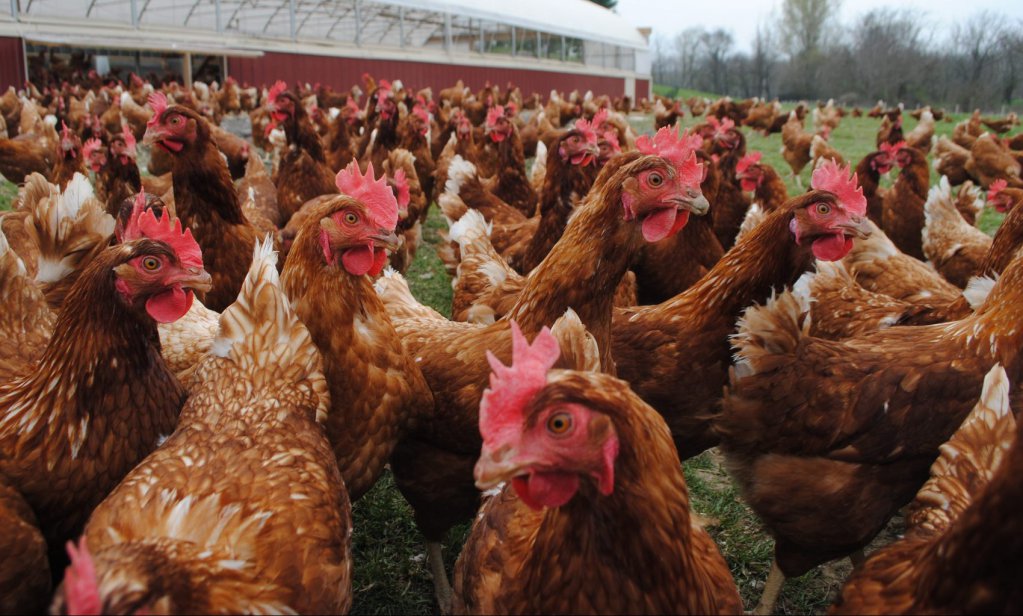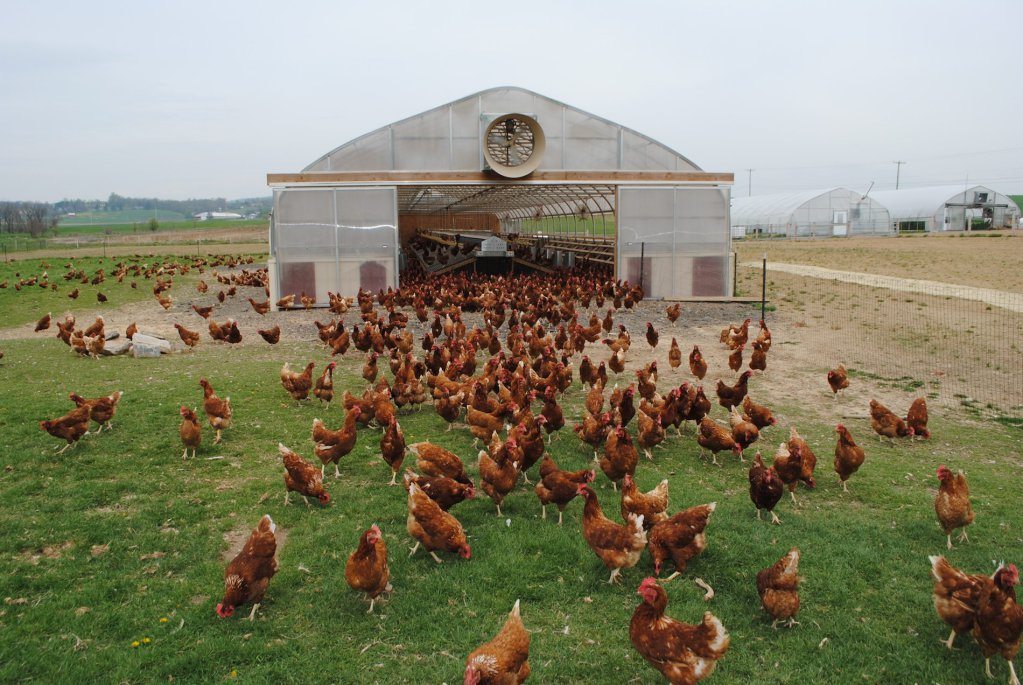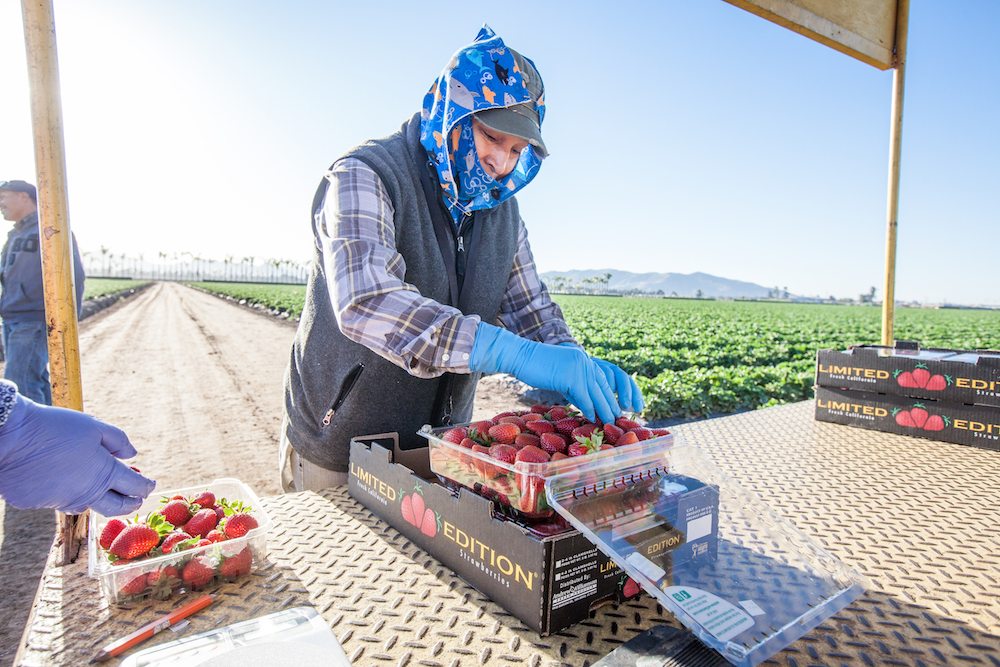
Joe Fassler
For decades, most American egg producers have kept their hens inside, claiming outdoor access isn’t feasible at scale. Part one of our series introduced Vital Farms and Handsome Brook Farm, two companies that say they’ve figured out how to sell millions of eggs with the barn doors open.
What does commercial-scale pasture-raised actually look like in practice? In April, I drove out to one of the Handsome Brook partner farms in Lititz, Pennsylvania to see for myself.
The operation is so small that I drive past it by mistake. As I double back, a man waves to me from the driveway. It’s Broc Turner, Handsome Brook’s director of live operations. He’s a poultry expert who worked for Perdue Chicken for many years and, for a time, was personal assistant to Frank himself. Turner says he never thought putting hens outside was possible, but now he wouldn’t go back.
We put on hairnets and fasten big plastic socks around our boots. Then we walk out back.
The barn is a converted hoop house, the kind typically used for growing vegetables. Turner says that the farmer built it that way so that, if chickens didn’t work out, he could go back to growing produce. We pass through the front door into a small packing room where several hundred eggs are stacked in packing crates next to a large sorting machine, then into the large room where the birds have spent the night.
 Joe Fassler
Joe Fassler I hear them first: an endless ocean of gobbles and coos. And then I’m faced with 2,500 brown chickens. For a minute I stand there, awed. It’s visually overwhelming to witness so many identical creatures, all Hyline/ISA Brown crosses, all with the same bright red comb, looking at me with the same yellow eyes. To walk through the barn is to part a shallow, brown sea. Their bodies dodge gently away from our feet with each step.
The birds hop up and down from raised perches, where six additional square inches of space are allotted per bird. The perches lead to rows of nesting boxes, and the eggs drop down onto a long, hidden conveyor belt. The hens certainly aren’t confined. They have plenty of space to move around. But especially around the feeders, it’s a little like the chicken equivalent of maneuvering through a crowded subway car at rush hour.
 Joe Fassler
Joe Fassler The hens don’t look distressed, either. Their coats are glossy. The barn is well-lit and ventilated, and the air is pleasant to breathe. I’ve stood outside conventional laying barns where the stench of animals and ammonia can make your eyes water. Turner says the Handsome Brook houses have a mortality rate of less than 1 percent, far lower than the 5 to 10 percent you see in conventional houses. Still, the sheer number of birds provokes a visceral, gut-level response: It feels commercial-scale. You start to sense the enormous effort it takes to stock all those grocery store shelves. But industrial? Not exactly. There’s something going on here that’s different. It’s big and busy and efficient without feeling inhumane.
 Joe Fassler
Joe Fassler And it’s just for the night. Every morning at 11, the hens go out.
The company’s commitment to providing daily outdoor access is, of course, its mission and main selling point—though we don’t just have to take their word for it. In order to stay American Humane Certified for a pasture-raised product, each farm undergoes an annual inspection to ensure birds have 108 square feet of pasture apiece. I’m not present to see the doors roll open, but I come back in the afternoon to see what that looks like.
 Michael George
Michael George A Handsome Brooke farm in Franklin, NY
Large portions of the flock hesitate in the entryways, seemingly not sure whether they want to leave the safety of the barn, the water, and the feed. As I walk through the field, the hens follow me through the meadow and peck inquisitively at my boots. I notice their beaks are nicked at the end; they have been clipped early in life, the mark of a commercial-grade hen. But it does seem nice to be a Handsome Brook chicken. The pasture is lush and green and there is more than enough space. The birds wander all over, pecking through the grass. There’s even a brook running through it, with a little wooden bridge. It looks, actually, like something you’d see on the front of an egg carton.
When applied to eggs, the label terms “organic,” “cage-free” and “free-range” cynically evoke a pastoral vision that masks an uncomfortable truth. At the farm in Lititz, at least, the marketing and reality seem far less dissonant. That’s not to say the “pasture-raised” label tells the full story. Vital Farms and Handsome Brook use routine industry practices I suspect many consumers would find objectionable, if they only knew: their chicks come from suppliers that mass cull the males; they trim the hens’ beaks; they sell spent hens for meat after a brief life. But can you blame producers for the confusion?
 Joe Fassler
Joe Fassler Until people understand that scale means tradeoffs, that convenience and affordability come with costs of a different sort, they’ll always be willingly misled.
The question, then, isn’t whether Handsome Brook farms look like Little House on the Prairie. The question is which tradeoffs can you live with? I’m standing in a pasture with several hundred basically happy hens. It seems like a luxury to be able to buy a dozen of these eggs for around six bucks at a Costco. Maybe that’s good enough.










